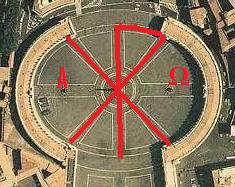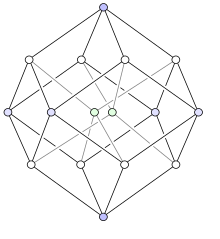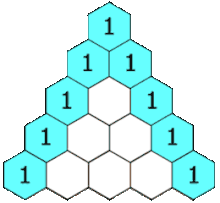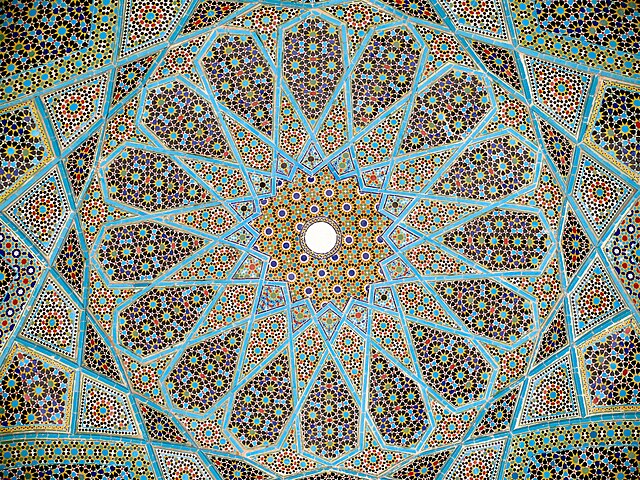|
Reply |
Message 1 of 20 on the subject |
|
EL ISLAM ESTA DISEÑADO (ESOTERICAMENTE) EN FUNCION A VENUS Y LA LUNA CRECIENTE (RESURRECCION DE CRISTO FRENTE A MARIA MAGDALENA FUE EN LUNA CRECIENTE)
SABEMOS QUE VENUS, esta diseñado en funcion al numero de oro Phi, en funcion a su ciclo en funcion a la tierra y el sol. La luna creciente es una REFERENCIA A ISHTAR (MADRE ENGENDRA UNA ESTRELLA/GRIAL)
ISHTAR EN LA BIBLIA TIENE FUERTE RELACION CON BENJAMIN (HIJO DE JOSE) QUE ES UN TIPO DEL SANTO GRIAL.
Istar con la luz como simbolo de la iluminacion.
La posicion de LA MECA, que segun los arabes esta en el Monte Paran, tambien esta diseñada en funcion al numero de oro.
|
|
|
|
www.youtube.com/watch?v=f0f-LugkXts14 May 2009 - 10 min - Subido por kewserx
Number of Golden Ratio, mystery of Kaaba, Miracle of Islam and Koran, it is the high time for Divine Secrets ...
|
|
|
|
|
www.youtube.com/watch?v=hD2323zkQUM20 Abr 2009 - 10 min - Subido por HighFlyingDutchman
Presenting the clear scientific facts that the 'holy' city of Islam is in the Golden Ratio point of the world. It ...
|
Millones de musulmanes esperan el MAHDI.
EL CORAN, kavalisticamente tiene fuerte relacion con el numero 19, QUE TIENE FUERTE NEXO CON MARIA.
EL 911 AMERICANO TIENE UN FUERTE NEXO CON EL ISLAM.
FATIMA ERA LA ONCEAVA HIJA DE MAHOMA.
EL RAMA DAN (PENTECOSTES MUSULMAN) TIENE FUERTE RELACION CON EL GRIAL. JUSTAMENTE RAMA DAN ES UNA REFERENCIA A LA RAMA EN EL CONTEXTO A LA SERPIENTE. SERPIENTE TIENE FUERTE NEXO CON LA TRIBU DE DAN/JUSTICIA. DAN BROWN ES EL ESCRITOR DEL "CODIGO DA VINCI"

The Black Cube Cult
“Pan was a composite creature, the upper part–with the exception of his horns–being human, and the lower part in the form of a goat. (…)The pipes of Pan signify the natural harmony of the spheres, and the god himself is a symbol of Saturn because this planet is enthroned in Capricorn, whose emblem is a goat”
- Manly P. Hall, Secret Teachings of All Ages
So Pan was depicted with horns due to the fact it represented Saturn, the ruler of the house of Capricorn which symbol is a goat.
Actually, the Mardi Gras celebration originated in the pagan pre-Christian celebration of spring. Ancient Greeks would sacrifice a goat, cut its hide in to strips and run naked through the fields while their pagan priests lashed them with the goat-hide strips. This was a part of their spring fertility rite to insure a productive harvest for their fields and increase the fertility of their flocks and women. The custom was degenerate even by pagan standards, being a time of lewdness, immorality, drunkenness and revelry and was associated with the worship of the Greek god "Pan". "Most scholars see a relationship between present day Mardi Gras and the ancient tribal rituals of fertility that welcomed the arrival of Spring. A possible ancestor of the celebration is the Lupercalis, a circus-like orgy held in mid-February in Rome." the day before Ash Wednesday was Carnival! It meant "farewell to flesh" (at least for the Lenten season). The French called it Mardi Gras for Fat TuesdayWhat's Really Behind the Mardi Gras Masks? "But behind the sequins and war paint, and deep under the light-hearted Carnival spirit, is there some quirk in the human personality that makes people want to mask? And if so, is there some twist in each individual's psyche that makes him choose the alter-identity he does? Enter the anthropologists and sociologists, who assure us that yes, there certainly may be a darker side to Carnival. Joseph V. Guillotte, Ph.D., associate professor of anthropology at the University of New Orleans, says that maskers have been traced at least as far back as the Ice Age. The proof is a dated drawing from southwestern France of the Dancing Sorcerer, a man dressed in a reindeer costume. Among early man, masking was considered a conduit to the supernatural, Guillotte says. A man donned a mask and believed he was possessed by the spirit of a god or dead ancestor who was trying to communicate with the living. "the individual becomes the character the mask depicts... Masking (or costuming) altered the state of consciousness."5 In the same article, Fuller quotes Fred Koening, Ph.D., professor of social psychology at Tulane University: "Masks are a way of being anonymous, and if you wear a mask, ' you take on a different persona.' Among the early tribes, men who wore masks were considered crueler toward their enemies than those who did not. Certainly nobody is claiming that masking at Carnival. has anything to do with cruelty. But, Koening says, 'You can be a little drunker, a little wilder, a little more primitive.' Furthermore, at Carnival 'people will be more tolerant of you,' he says. 'Normal rules are gone. Traditional routines are put on hold.'" The Masks of Carnival was easily influenced the African and Indian population of America because it had a connection to their rituals for the dead. http://saintpaulcommunitychurch.org/spiritofmardigras.htm Pan ....and Saunieres angels over pan Rosslyn Chapel and the head of the goat on the roof  The importance of the number 8Kabba...The Kaaba, was erected in the center of Mecca’s shrine area, where Venus as a meteorite has been worshipped for thousands of years. The importance of the number 8Kabba...The Kaaba, was erected in the center of Mecca’s shrine area, where Venus as a meteorite has been worshipped for thousands of years. The cube shape of the Kaaba incorporates the alchemical number eight by having two four-sided squares, one above and one below (4+4), thus emphasizing and enhancing the alchemical properties of its indwelling form of Venus. Eight symbolizes the number of perfect expression, the octagon, the cube. As mentioned, the number 8 denoted both enlightenment as well as the two “worlds, “ Heaven and Earth, a point made explicit by the builders of the Kaaba, who incorporated into its structure thirty-one courses of stone and wood, then added two more, symbolizing Heaven and Earth, thus making thirty-three, the number of enlightenment.In particular the Semites regarded trees, caves, springs, and large stones as being inhabited by spirits; like the Black Stone of Islam in a corner of the Ka'bah at Mecca, in Petra and other places in Arabia stones were venerated also" (History of the Islamic Peoples, Carl Brockelmann, p 8-10) "According to a theory held by many, this temple [Kabah] had been sourceally connected with the ancient worship of the sun, moon and stars, and its circumambulation by the worshippers had a symbolical reference to the rotation of the heavenly bodies. Within its precincts and in its neighborhood there were found many idols, such as Hubal, Lat, Ozza, Manah, Wadd, Sawa, Yaghut, Nasr, Isaf, Naila, etc. A black stone in the temple wall was regarded with superstitious awe as eminently sacred" (Muhammad and Muhammadanism, S.W. Koelle, 1889, p. 17-19)
|
|
|
|
Reply |
Message 2 of 20 on the subject |
|

When molten sulphur is cooled, it solidifies into monoclinic sulphur. Sublimate of sulphur is called ‘flower of sulphur’. When sulphur is obtained by a chemical reaction as precipitate it is called ‘milk of sulphur’. These are made up of rhombic sulphur. Scientists have discovered many more allotropes of sulphur under different conditions.
All of them get transformed into rhombic sulphur at room temperature.
Sulphur has catenating power. It forms strong S-S covalent bonds. This results in formation of Sg molecules. Sg molecules have a shape of a crown like ring (Fig. 1.5). Both, rhombic and monoclinic sulphur contain S8 rings. At high temperatures smaller molecules like Sg, S4, S2, S also exist.

 |
| Rhombic sulfur and the unfinished pyramid |
 |
| Kether the Crown of the Kabbalah |
Sulfur or sulphur ( /ˈsʌlfər/ SUL-fər; see spelling below) is the chemical elementwith atomic number 16, represented by the symbol S. It is an abundant, multivalentnon-metal. At normal conditions, sulfur atoms form cyclic octatomic molecules with chemical formula S8. Elemental sulfur is a bright yellow crystalline solid. Chemically, sulfur can react as either an oxidant orreducing agent. It oxidizes most metals and several nonmetals, including carbon, which leads to its negatives charge in mostorganosulfur compounds, but it reduces several strong oxidants, such as oxygenand fluorine. /ˈsʌlfər/ SUL-fər; see spelling below) is the chemical elementwith atomic number 16, represented by the symbol S. It is an abundant, multivalentnon-metal. At normal conditions, sulfur atoms form cyclic octatomic molecules with chemical formula S8. Elemental sulfur is a bright yellow crystalline solid. Chemically, sulfur can react as either an oxidant orreducing agent. It oxidizes most metals and several nonmetals, including carbon, which leads to its negatives charge in mostorganosulfur compounds, but it reduces several strong oxidants, such as oxygenand fluorine.
In nature, sulfur can be found as the pure element and as sulfide and sulfate minerals. Elemental sulfur crystals are commonly sought after by mineral collectors for their brightly colored polyhedron shapes. Being abundant in native form, sulfur was known in ancient times, mentioned for its uses inancient Greece, China and Egypt.

 |
| St Peters Square Vatican octagonal division |
 |
| Mount temple top view |
 |
| Mount temple fron view |
 |
| Orpheus ceiling |


Honey comb


 |
| Copper sulfate crystal |
The rhombic dodecahedron forms the hull of the vertex-first projection of a tesseract to 3 dimensions. There are exactly two ways of decomposing a rhombic dodecahedron into 4 congruent parallelepipeds, giving 8 possible parallelepipeds. The 8 cells of the tesseract under this projection map precisely to these 8 parallelepipeds.
The rhombic dodecahedron forms the maximal cross-section of a 24-cell, and also forms the hull of its vertex-first parallel projection into 3 dimensions. The rhombic dodecahedron can be decomposed into 6 congruent (but non-regular) square dipyramids meeting at a single vertex in the center; these form the images of 6 pairs of the 24-cell’s octahedral cells. The remaining 12 octahedral cells project onto the faces of the rhombic dodecahedron. The non-regularity of these images are due to projective distortion; the facets of the 24-cell are regular octahedra in 4-space.

This decomposition gives an interesting method for constructing the rhombic dodecahedron: cut a cube into 6 congruent square pyramids, and attach them to the faces of a second cube. The triangular faces of each pair of adjacent pyramids lie on the same plane, and so merge into rhombuses. The 24-cell may also be constructed in an analogous way using two tesseracts.
The tesseract represents 4 th dimension and is the projection or shadow of the rhombic dodecahedron
 |
| A 3D projection of an 8-cell performing adouble rotation about two orthogonal planes |
1111 familiar ?
 |
| The rhombic dodecahedron forms the convex hull of the tesseracts vertex-first parallel-projection. The number of vertices in the layers of this projection is 1 4 6 4 1 – the fourth row in Pascal’s triangle. |
Pascal triangle
 |
| Each number in the triangle is the sum of the two directly above it. |
Patterns and properties
Pascal’s triangle has many properties and contains many patterns of numbers.
- When adding all the digits in a single row, each successive row has twice the value of the row preceding it. For example, row 1 has a value of 1, row 2 has a value of 2, row 3 has a value of 4, and so forth.
- The value of a row, if each entry is considered a decimal place (and numbers larger than 9 carried over accordingly) is a power of 11 ( 11n, for row n). Thus, in row two, ’1,2,1′ becomes 112, while ’1,5,10,10,5,1′ in row six becomes (after carrying) 161,051, which is 115. This property is explained by setting x = ’10′ in the binomial expansion of (x + 1)row=n, and adjusting values to the decimal system. But x can be chosen to allow rows to represent values in any base – such as base 3; 1 2 13['1,2,1'] = 42 (16), 2 1 0 13 ['1,3,3,1'] = 43 (64) – or base 9; 1 2 19 = 102 (100), 1 3 3 19 = 103 (1000) and 1 6 2 1 5 19 ['1,5,10,10,5,1'] = 105 (100,000). In particular (see next property), for x = 1 place value remains constant(1place=1). Thus entries can simply be added in interpreting the value of a row.
- The sum of the elements of row m is equal to 2m−1. For example, the sum of the elements of row 5 is 1 + 4 + 6 + 4 + 1 = 16, which is equal to 24 = 16. This follows from the binomial theorem proved above, applied to (1 + 1)m−1.
- If rows are numbered starting with n = 0, the sum of the elements in the row is simply 2n, so row 0 adds to 20 = 1, row 1 adds to 21 = 2, etc.
- Some of the numbers in Pascal’s triangle correlate to numbers in Lozanić’s triangle.
- The sum of the squares of the elements of row m equals the middle element of row (2m − 1). For example, 12 + 42 + 62 + 42 + 12 = 70. In general form:

- Another interesting pattern is that on any row m, wherem is odd, the middle term minus the term two spots to the left equals a Catalan number, specifically the (m + 1)/2 Catalan number. For example: on row 5, 6 − 1 = 5, which is the 3rd Catalan number, and (5 + 1)/2 = 3.
- Another interesting property of Pascal’s triangle is that in rows where the second number (immediately following ’1′) is prime, all the terms in that row except the 1s are multiples of that prime.
Square dipyramids or octahedron
A particularly popular polyhedron is the pyramid. If we restrict ourselves to regular polygons for faces, there are three possible pyramids: the triangle-based tetrahedron, the square pyramid, and the pentagonal pyramid. Being bounded by regular polygons, these last two fall within the class of Johnson solids. One interesting property of pyramids is that like the tetrahedron, their duals are also pyramids. (Incidentally, the Egyptian pyramids have square bases but the triangular side faces are not quite equilateral; they are very close to half a golden rhombus.)

 |
Louvre Pyramid and rhombic sulfur
|
Everything is Connected and there are no
coincidences
|
|
|
|
Reply |
Message 3 of 20 on the subject |
|
|
|
|
Reply |
Message 4 of 20 on the subject |
|
that is sooo right great point Sufis believe they are practicing Ihsan (perfection of worship) as revealed by Gabriel to Muhammad, "Worship and serve Allah as you are seeing Him and while you see Him not yet truly He sees you." the Archangel Gabriel plays a big part in the Koran  Moolah temple at Saint Louis Whoop is right its Egyptian/moorish  http://www.flickr.com/photos/bweston23/4703199733/ http://www.flickr.com/photos/bweston23/4703199733/this is just Awesome  Geometric arabesque tiling on the underside of the dome of Hafiz's tomb in Shiraz. Saladin The Latin Kingdom formed in the following year lasted until Saladin destroyed King Guy's army at the Horns of Hettin in 1187 and shortly after recovered Jerusalem. In stark contrast to the Crusades 88 years earlier, Saladin, adhering to the teachings of Islam, did not slaughter the city's Christian inhabitants. Saladin's noble act won him the respect of his opponents and many more people throughout the world. King Richard I of England, better known as Richard the Lionheart, who led the Third Crusade in 1189 to recover the Holy City, met Saladin in a conflict that was to be celebrated in later chivalric romances. Although the Crusaders failed in their purpose, Richard the Lionheart gained Saladin's lifelong respect as a worthy opponent. Saladin's generosity and sense of honor in negotiating the peace treaty that ended the Crusade won him the lasting admiration and gratitude of the Christian World. Many Crusaders discovered that Muslims, like them, possess virtues the Christians considered sacred. In fact, some Christians thought that "Saladin had European blood in his veins, and was a Christian knight at heart." To Muslims, Saladin was more than just a warrior. He was a man of piety and true faith and vision; he was a builder, a patron of literature and chivalry.
_________________
Everything is Connected and there are no
coincidences |
|
|
|
Reply |
Message 5 of 20 on the subject |
|
Saladin Saladin grew up in a Muslim society that was powerfully influenced by Sufism. Sufism is a school of Islam whose members seek higher spiritual life and closer intimacy with God. The essence and divine values of the religion of Islam were the center stage of practice as opposed to a superficial practice. The degree of closeness to God by the virtue of thikr, the private and congregational meditation and recollection of God in the heart and mind, and the work for tazkiyah (purification of inner-self and soul) was an every day norm. The divine principles such as chivalry, piety, nobility, justice, humbleness, generosity, caring, love, brotherhood, mercy and forgiveness were a living reality in hearts and minds of the mass majority of Muslims. http://www.islamic-study.org/saladin_%28salahu_ad-deen%29.htmAccording to the Spanish Muslim traveler Ibn Jubayr, who was a contemporary of Saladin, Damascus was a heaven for all: Christians, Jews and Muslims. He stated: "Damascus was the most populated city in the world. Behind the city walls the streets were narrow, lined with three-story houses of mud and reeds. The bazaars were noisy with metal workers and fragrant with spices. There were many public baths. There were twenty colleges for students of law and religion and a large free hospital. The Orthodox Christian church of St. Mary was brilliant with mosaics, and worshippers there were freely allowed to practice their religion. The rich Jewish community of some 3000, many of them refugees from the Latin Kingdom of Jerusalem, ran their own university. The Ummayad Mosque-Damascus, Syria has two pillars the Minaret of the Bride, was not just a place from where the muezzin could make his call to prayer, but a building with sizable apartments for occupation by scholars who, as was then customary, passed from one center of learning to another. The topmost one was occupied for two years by al-Ghazali. The second Minaret is called the Minaret of Jesus. Prophet Jesus, as Muslims believe, will be returning to earth, and will start his call from this minaret. Muslims and Christians together will then respond to his call. The Grand Mufti of Syria, Shaykh Ahmad Kuftaro calls on both Muslims and Christians to work together paving the road for his return. The Umayyad Mosque was originally east of St. John Baptist Church. Muslims and Christians for seventy years performed their rituals side by side, before the Mosque expansion during Caliph al-Walid ibn Abdul Malek, in 705. He bought the St. John Baptist Church from the Christians in exchange for four other churches in the city. Today, the tomb of John the Baptist stands is in the center of the Umayyad Mosque along with the original baptismal well and stone-made pot.
_________________
Everything is Connected and there are no
coincidences |
|
|
|
 First
First
 Previous
2 a 5 de 20
Next
Previous
2 a 5 de 20
Next Last
Last
|

